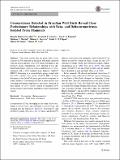| dc.contributor.author | Arns, Clarice W | |
| dc.contributor.author | Caserta, Leonardo C. | |
| dc.contributor.author | Barnabé, Ana C. S. | |
| dc.contributor.author | Martini, Matheus C. | |
| dc.contributor.author | Ferreira, Helena L. | |
| dc.contributor.author | Felippe, Paulo A. N. | |
| dc.contributor.author | Santos, Márcia B. | |
| dc.contributor.author | Arns, Clarice W. | |
| dc.contributor.author | Carvalho, Ricardo Duraes de | |
| dc.date.accessioned | 2016-10-28T19:19:01Z | |
| dc.date.available | 2016-10-28T19:19:01Z | |
| dc.date.issued | 2015-08 | |
| dc.date.submitted | 2015-06 | |
| dc.identifier.issn | 0022-2844 | |
| dc.identifier.issn | 1432-1432 | |
| dc.identifier.uri | http://hdl.handle.net/1721.1/105146 | |
| dc.description.abstract | This study showed that the most of the coronaviruses (CoVs) detected in Brazilian wild birds clustered with the mouse hepatitis virus A59 strain, belonging to the BetaCoV group. Furthermore, CoV detected in two different bird species, Amazona vinacea and Brotogeris tirica, clustered with a CoV isolated from Sparrow (SpaCoV HKU17) belonging to a monophyletic group related with the CoVs isolated from swines (PorCoV HKU15), both belonging to the DeltaCoV genus, previously unreported in South America. Considering the risk of inter-species host switching and further adaptation to new hosts, detection in bird species of CoVs closely related to mammal CoVs should warn for the potential emergence of new threatening viruses. | en_US |
| dc.description.sponsorship | Fundação de Amparo à Pesquisa do Estado de São Paulo (Grants 2013/03922-6 and 2011/50919-5) | en_US |
| dc.publisher | Springer US | en_US |
| dc.relation.isversionof | http://dx.doi.org/10.1007/s00239-015-9693-9 | en_US |
| dc.rights | Article is made available in accordance with the publisher's policy and may be subject to US copyright law. Please refer to the publisher's site for terms of use. | en_US |
| dc.source | Springer US | en_US |
| dc.title | Coronaviruses Detected in Brazilian Wild Birds Reveal Close Evolutionary Relationships with Beta- and Deltacoronaviruses Isolated From Mammals | en_US |
| dc.type | Article | en_US |
| dc.identifier.citation | Durães-Carvalho, Ricardo et al. “Coronaviruses Detected in Brazilian Wild Birds Reveal Close Evolutionary Relationships with Beta- and Deltacoronaviruses Isolated From Mammals.” Journal of Molecular Evolution 81.1–2 (2015): 21–23. | en_US |
| dc.contributor.department | Massachusetts Institute of Technology. Department of Chemistry | en_US |
| dc.contributor.mitauthor | Carvalho, Ricardo Duraes de | |
| dc.relation.journal | Journal of Molecular Evolution | en_US |
| dc.eprint.version | Author's final manuscript | en_US |
| dc.type.uri | http://purl.org/eprint/type/JournalArticle | en_US |
| eprint.status | http://purl.org/eprint/status/PeerReviewed | en_US |
| dc.date.updated | 2016-08-18T15:41:04Z | |
| dc.language.rfc3066 | en | |
| dc.rights.holder | Springer Science+Business Media New York | |
| dspace.orderedauthors | Durães-Carvalho, Ricardo; Caserta, Leonardo C.; Barnabé, Ana C. S.; Martini, Matheus C.; Ferreira, Helena L.; Felippe, Paulo A. N.; Santos, Márcia B.; Arns, Clarice W. | en_US |
| dspace.embargo.terms | N | en |
| dc.identifier.orcid | https://orcid.org/0000-0003-1335-3721 | |
| mit.license | PUBLISHER_POLICY | en_US |
| mit.metadata.status | Complete | |
